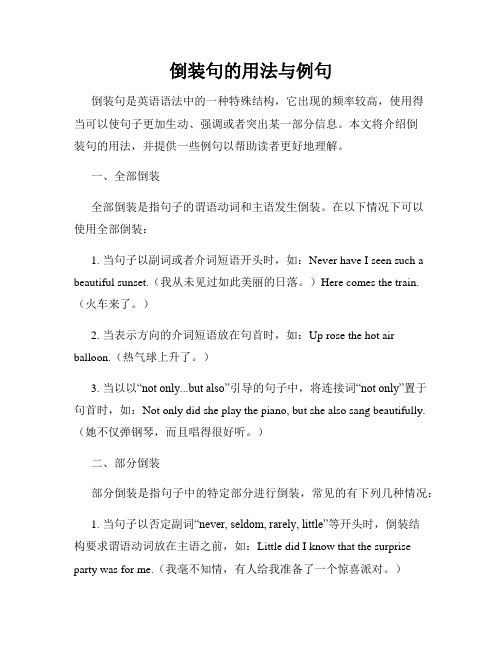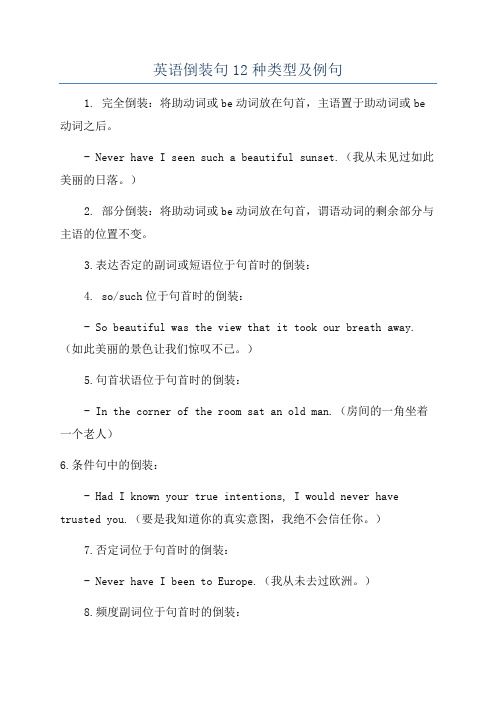倒装句经典用法
- 格式:ppt
- 大小:329.50 KB
- 文档页数:30

倒装句的用法与例句倒装句是英语语法中的一种特殊结构,它出现的频率较高,使用得当可以使句子更加生动、强调或者突出某一部分信息。
本文将介绍倒装句的用法,并提供一些例句以帮助读者更好地理解。
一、全部倒装全部倒装是指句子的谓语动词和主语发生倒装。
在以下情况下可以使用全部倒装:1. 当句子以副词或者介词短语开头时,如:Never have I seen such a beautiful sunset.(我从未见过如此美丽的日落。
)Here comes the train.(火车来了。
)2. 当表示方向的介词短语放在句首时,如:Up rose the hot air balloon.(热气球上升了。
)3. 当以以“not only...but also”引导的句子中,将连接词“not only”置于句首时,如:Not only did she play the piano, but she also sang beautifully.(她不仅弹钢琴,而且唱得很好听。
)二、部分倒装部分倒装是指句子中的特定部分进行倒装,常见的有下列几种情况:1. 当句子以否定副词“never, seldom, rarely, little”等开头时,倒装结构要求谓语动词放在主语之前,如:Little did I know that the surprise party was for me.(我毫不知情,有人给我准备了一个惊喜派对。
)2. 当句子以表示条件的副词或者介词短语开头时,也可以使用倒装,如:Should you need any assistance, please feel free to ask.(如果你需要任何帮助,请随时提问。
)In case of emergency, break the glass.(紧急情况下,打破玻璃。
)3. 当句子中有“so/such...that”结构时,可以使用倒装结构,如:She was so tired that not only could she not finish her homework, but she alsofell asleep in class.(她太累以至于不仅没有完成她的家庭作业,还在课堂上睡着了。

倒装句的使用场景倒装句是英语语法中一种重要的句式结构,它的使用场景广泛。
本文将讨论倒装句在不同语境中的应用,并对其用法进行详细解析。
一、完全倒装句1. 以副词或者短语置于句首完全倒装句通常以副词或短语作为句首,可以简化句子结构,增强语气,或强调句子的某个成分。
例如:Out rushed the crowd.倒装后:The crowd rushed out.Never have I seen such a beautiful sunset.倒装后:I have never seen such a beautiful sunset.Under the tree sat a little girl.倒装后:A little girl sat under the tree.2. 以否定词置于句首当以否定词(如not, never, seldom)置于句首时,为了强调否定意义,句子常需要完全倒装。
例如:Not a single word did he say.倒装后:He did not say a single word.Never before have I tasted such delicious food.倒装后:I have never before tasted such delicious food.Seldom does he complain about his problems.倒装后:He seldom complains about his problems.二、部分倒装句1. 以表示否定意义的词或短语置于句首部分倒装句中,只有谓语动词的一部分与主语之间发生倒装。
当以否定词或短语置于句首时,谓语动词的助动词或情态动词与主语进行倒装。
例如:Not only does she play the piano, but she also sings beautifully.倒装后:She not only plays the piano, but also sings beautifully.On no condition should you give up.倒装后:You should not give up on no condition.2. 以表地点、方式、原因的状语置于句首当以表示地点、方式或原因的状语置于句首时,为了强调状语的重要性,常需要进行倒装。

倒装句的用法倒装句是指将正常语序中的主语和动词调换位置,用来强调某个句子部分或使句子结构更加丰富多样。
倒装句具有一定的语法要求,使用时需要注意一些规则和注意事项。
一.全部倒装句全部倒装句是指将整个谓语动词放在主语之前,常见的情况有以下几种:1.以副词或介词短语开头的倒装句常见的副词或介词短语包括"never"、"seldom"、"only"、"hardly"、"scarcely"、"in no way"等,例如:Never have I seen such a beautiful sunset.Seldom do we have time to relax.Only in this way can we achieve success.Hardly had I finished my meal when the phone rang.2.以否定词开头的倒装句以否定词开头的倒装句中,常见的否定词有"not"、"no"、"never"等,例如:Not until she left did he realize his mistake.No sooner had I arrived home than it started to rain.Never have I heard such a strange story.3.以表示"方向、方式、程度"等意义的副词或短语开头的倒装句常见的表示方向、方式、程度的副词或短语有"down"、"up"、"out"、"in"、"here"、"there"等,例如:Down rushed the boy to the playground.Up went the balloon into the sky.Out came a cat from the bushes.二.部分倒装句部分倒装句是指将助动词、情态动词或系动词与主语调换位置,常见的情况有以下几种:1.以助动词或情态动词开头的倒装句助动词包括"do"、"does"、"did"等,情态动词包括"can"、"could"、"will"、"would"、"shall"等,例如:Can you swim? —— Can swim you?Did she go to the party? —— Did go she to the party?Could I have a cup of tea? —— Could have I a cup of tea?2.以系动词开头的倒装句系动词包括"be"、"am"、"is"、"are"、"was"、"were"等,例如:Is he a doctor? —— Is a doctor he?Are they twins? —— Are twins they?Was she late for the meeting? —— Was late she for the meeting?三.特殊情况的倒装句除了以上常见的倒装句用法,还有一些特殊情况需要注意:1.在条件状语从句中的倒装句只有出现在条件状语从句中的"had"才能放在主语之前,例如:Had I known his address, I would have sent him an invitation.2.以"so"开头的倒装句以"so"开头的倒装句常常用来表示结果或原因,例如:So great was his joy that he couldn't help crying.3.在虚拟语气中的倒装句在虚拟语气中的倒装句中,动词"were"常用于所有人称,例如:Were I younger, I would travel around the world.综上所述,倒装句的用法在英语中是非常常见的,它能够使句子更加生动有趣,让语言表达更加多样化。

英语倒装句用法经典总结英语倒装句是一种语法现象,用法广泛,能够提高句子的表达力和语言的鲜明度。
它常用于强调句子中的某个部分,或使句子结构更为紧凑。
下面是关于英语倒装句用法的经典总结。
一、完全倒装句1. 在句首出现的副词或短语:用于表示地点的副词(here, there)或表示方式的副词(in this way, in no case)等。
例:There goes the bus.Here comes the teacher.In no case should you tell him the secret.2. 情态动词、助动词或be动词在句首:在由情态动词(can, could, may, might, must, shall, should, will, would等)引导的疑问句或条件句中,情态动词需要放在句首。
例:Can you swim?Should you have any questions, please feel free to ask.3. 在虚拟条件句中:在虚拟条件句中,如果主语是名词,则将were放在句首。
例:Were I to win the lottery, I would buy a house.4. 否定词位于句首:如果句子中存在否定词,如never, seldom, not only...but also等,否定词需要放在句首。
例:Never have I seen such a beautiful sunset.Not only is he clever, but also hardworking.5. Only修饰副词、介词短语或状语从句时:当only修饰副词、介词短语或状语从句时,倒装现象会出现。
例:Only in this way can we solve the problem.Only when he arrived did she start to cook.6. 某些表示条件的介词短语:由in case, in the event that或on condition等表示条件的介词短语引导的句子中,介词短语需要放在句首。

倒装句用法总结范文
倒装句是一种常见的语法结构,在句子中将主语和谓语动词的位置调换。
倒装句的主要用途是用来强调句子中的其中一成分,或者用于特殊的
语法结构。
下面是倒装句的常见用法总结:
1.全倒装句:将助动词、情态动词或感叹词放在主语之前,谓语动词
跟在主语后面。
例如:“Never have I seen such a beautiful sunset.”(我从来没有见过如此美丽的日落。
)
2.部分倒装句:将助词、情态动词或谓语动词前置,谓语动词和主语
顺序不变。
例如:“Only by studying hard can you pass the exam.”(只有通过努力学习你才能通过考试。
)
3.状语倒装句:将状语前置,形成倒装结构。
例如:“On the top
of the hill stood a large tree.”(山顶上有一棵大树。
4.疑问句倒装:在疑问句中将助词、情态动词或谓语动词与主语互换
位置。
例如:“Are you going to the party?”(你要去聚会吗?)需要注意的是,在倒装句中,如果有两个动词,只将助词或情态动词
提前,而谓语动词保持不变的位置。
例如:“I should have gone.”
(我本应该去的。

英语倒装句12种类型及例句1. 完全倒装:将助动词或be动词放在句首,主语置于助动词或be 动词之后。
- Never have I seen such a beautiful sunset.(我从未见过如此美丽的日落。
)2. 部分倒装:将助动词或be动词放在句首,谓语动词的剩余部分与主语的位置不变。
3.表达否定的副词或短语位于句首时的倒装:4. so/such位于句首时的倒装:- So beautiful was the view that it took our breath away.(如此美丽的景色让我们惊叹不已。
)5.句首状语位于句首时的倒装:- In the corner of the room sat an old man.(房间的一角坐着一个老人)6.条件句中的倒装:- Had I known your true intentions, I would never have trusted you.(要是我知道你的真实意图,我绝不会信任你。
)7.否定词位于句首时的倒装:- Never have I been to Europe.(我从未去过欧洲。
)8.频度副词位于句首时的倒装:- Rarely do we see such dedication.(我们很少见到如此的奉献精神。
)9.祈使句或祈使句部分的倒装:- Stand up!(站起来!)- Be quiet, please.(请安静。
)10. only位于句首时的倒装:- Only by working hard can you achieve your goals.(只有通过努力工作,你才能实现目标。
)11.地点状语置于句首时的倒装:- In the garden were beautiful flowers.(花园里有美丽的花朵。
)12.宾语置于句首时的倒装:- A love like this I have never felt before.(我之前从未感受过如此的爱。
倒装句的使用技巧和特殊情况倒装句是英语中一种常用的句子结构,与常规语序相反,即将谓语动词或助动词放在主语之前。
倒装句的使用可以使句子更生动、更突出,同时也有一些特殊情况需要注意。
本文将介绍倒装句的使用技巧和特殊情况。
一、完全倒装句完全倒装句是指将整个谓语动词或助动词放在主语之前。
1.使用助动词倒装:— Are you ready for the exam?— Ready for the exam, are you?准备好考试了吗?准备好考试了。
在一般疑问句中,助动词通常位于主语之前,但在完全倒装句中,则将助动词与主语调换位置。
2.使用动词倒装:— In came the teacher with a smile on her face.— With a smile on her face, in came the teacher.老师笑着走了进来。
笑着走了进来的是老师。
在一些表达方式特殊的句子中,动词可以直接放在主语之前,使句子更加生动。
二、部分倒装句部分倒装句是指将谓语动词或助动词的某一部分放在主语之前。
常见的部分倒装句包括:否定副词、表示方向的副词、表示频率的副词、表示条件的介词短语等。
1.否定副词或词组倒装:— Never have I seen such a beautiful sunset.— Not only does she speak English, but she also speaks French.我从未见过如此美丽的日落。
她不仅会说英语,还会说法语。
在句首出现否定副词或词组时,谓语助动词或动词需要与主语倒装。
2.表示方向的副词倒装:— Up went the hot air balloon into the sky.— Down came the rain, washing away all the dust.热气球冉冉升起。
雨水下了下来,冲刷走了所有的尘埃。
在句首出现表示方向的副词时,谓语助动词或动词需要与主语倒装。
倒装句用法总结第1篇(1)only所修饰的副词/介词短语/状语从句位于句首时(但only修饰主语位于句首时不倒装);(2) never,hardly,seldom,scarcely,little,not…until,at no time,not once,not,no,in notime等否定意义的词位于句首时;(3) so…that中so或such…that中such位于句首时.方法:以上三种情况都倒装主句.(4)形容词/名词/动名词+as/though的让步状语从句中(although引导的让步状语从句不能倒装,though也可以不倒装);方法:倒装从句.(5) not only…but also连接并列分句时(连接主语时不倒装);方法:前倒后不倒.(6) neither…nor连接并列分句时(连接主语时不倒装);方法:前后都倒.(7)so位于句首表示前句的内容也同样适用于后一个人或物时(只能是肯定句,且前后两句主语不同);方法:so+助动词+主语.(8)neither/nor用于句首,表示前句的否定内容也适用于后一句的人/物时(只能用于否定句,且前后两句主语不同);方法:neither/nor+助动词+主语.(9) 表示祝愿的祈使句中:方法:副词+谓语+主语,may+主语+谓语.(10)在虚拟语气中,如果if条件从句有系动词were或助动词should/had,可以把其置于句首,同时省去if.●典型考题(答案分别为BBA)1. So difficult _________ it to work out the problem that I decided to ask Tom for advice.A. I did findB. did I findC. I have foundD. have I found2. _________ about wild plants that they decided to make a trip to Madagascar for further research.A. so curious the couple wasB. So curious were the coupleC. How curious the couple wereD. The couple was such curious3. —It’s burning hot today, isn’t it?—Yes. _________ yesterday.A. So was itB. So it wasC. So it isD. So is it特别说明:(1)若前面提出某一否定的情况,要表示后者也属于同样的否定情况,则应将其中的so改为neither或nor。
倒装句的用法归纳
倒装句的用法主要包括完全倒装和部分倒装。
完全倒装是指将句子中的谓语动词全部置于主语之前,常见的结构有:
1. 当句首是表示地点、时间、方位的副词,如here、there、in、up、down、on、out、back、then、away、off、over等,而谓语动词是rush、run、come、go、fly等不及物动词时,用全部倒装结构,此时的谓语动词不需要助动词。
例如:Out rushed the children.
2. 表示地点的介词短语位于句首时。
例如:On the wall hang two large portraits.
3. 当such置于句首时。
例如:Such are the facts, no one can deny them. 其中such当作表语.
4. 直接引语的部分或全部位于句首时,点明说话人的部分主谓语要倒装。
例如:“What are you doing?”asked she .
5. 在某些表示祝愿的句子中。
例如:Long live our great country!伟大的祖国万岁!
部分倒装是指将谓语的一部分如助动词或情态倒装至主语之前。
如果句中的谓语没有助动词或情态动词,则需添加助动词do, does或did,并将其置于主语之前。
以上信息仅供参考,如有需要,建议查阅语法书籍或咨询英语教师。
倒装句的运用知识点倒装句(Inverted Sentences)是英语语法中的一种常见句式,通常通过将谓语动词或助动词置于主语之前,从而改变句子的语序。
倒装句在英语中用得非常广泛,具有一定的表达效果和修辞功能。
本文将介绍倒装句的基本形式、用法和常见的几种情况。
一、基本形式1. 全倒装:将谓语动词完全置于主语之前。
例如:- Down the hill rolled the big stone.- Here comes the bus.2. 部分倒装:只将助动词、情态动词或现在分词置于主语之前。
例如:- Never have I seen such a beautiful sunset.- Not only does he play the piano, but he also sings well.二、用法1. 表示地点、时间或方向的状语置于句首。
例如:- In front of the house stood a tall tree.- On the wall hangs a picture.2. 强调句子的部分内容。
例如:- Only when we leave our comfort zone can we achieve greatness.- Not until the rain stopped did we continue our journey.3. 在条件句中,表示与实际情况相反的假设。
例如:- Were it not for your help, I would have failed the exam.- Had I known the truth, I would have acted differently.三、常见情况1. 在以"never"开头的句子中,谓语动词放在主语之前。
例如:- Never have I felt so alive.2. 在以"not only...but also"结构的句子中,谓语动词放在主语之前。